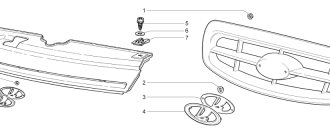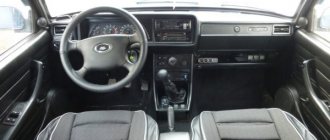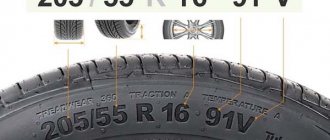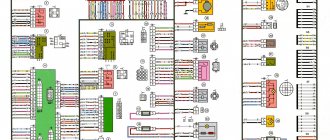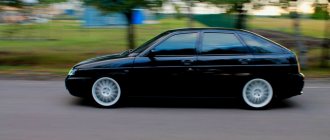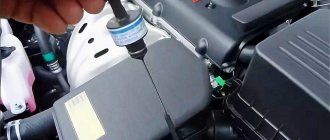The tenth family was developed all at once. The sedan was positioned as a car for all occasions, not without respectability, the station wagon was addressed to practical people, and the hatchback served as a kind of compromise between these qualities. At the same time, the latter was aimed at a young audience who lives within the city.
It is worth noting that the start of sales of the twelfth model was later than its counterparts, which to some extent affected its performance.
The history of the VAZ 2112 begins on February 3, 1998 - from that moment on, the model entered the assembly line of the Tolyatti Automobile Plant. However, full-scale production of the model started only in March 2000.
The concern positioned the new Lada as a car for all occasions, which has a swift design and compact dimensions. It is addressed to city dwellers who value practicality, but are not ready to choose the heavy proportions of a station wagon over dynamic lines.
AvtoVAZ Museum
Undoubtedly, the history of AvtoVAZ is eventful.
His products became a real symbol of that era. It is not surprising that there is an AvtoVAZ museum. It is located in Tolyatti. This institution is dedicated to the well-known Lada brand not only in our country, but also abroad. After all, it was he who became known to the whole world as a car made in our country. There are many exhibits significant for the auto giant on display here. Here you can find both the first models released after the collapse of the USSR and the oldest examples. Some of the cars presented at the exposition can no longer be seen on the roads. Not only have they not been produced for many years, but they have also been completely withdrawn from service.
The AvtoVAZ Museum is ready to show its visitors the first cherry-colored Kopeyka, which was sold through the sales network. Its owner has been using his car for more than 19 years. In 2000, he donated it to the museum. For this, AvtoVAZ presented the patron with a new car that had just rolled off the plant’s assembly line. This largest deserves fame and recognition.
LADA Granta
Lada Granta is a domestic front-wheel drive car, developed on the basis of LADA Kalina. The developers were given the goal of making a car that would be as close as possible to the Kalina in technical parameters and appearance, but to reduce its cost. The desire to reduce the cost undoubtedly affected the appearance of the car.
LADA Granta sedan differs from Kalina in how the car looks from the front. The front part features a stylish “pattern” of headlights, radiator grilles, license plate and logo sign. These elements are placed on a black backing in the shape of the letter X. From the side and rear, Granta repeats the LADA Kalina sedan.
Granta's trademark is the black X in the front of the car - it houses slanted headlights, a large brand logo and chrome “boomerangs” that visually unite the radiator and lower grilles
In 2014, production of Lada Granta Liftback began. Like the sedan, the liftback has an X-shaped design at the front. In addition, the model is distinguished by a convex roof, smoothly turning into a miniature rear part.
At the rear of the liftback are small horizontally elongated lights, a large fifth door and a bumper with a black insert stylized as a diffuser.
LADA Granta sport (2018 to this day) is a front-wheel drive sedan of the “subcompact” category. It is not particularly spacious, nor is the liftback. During its development, the emphasis was placed on modern dynamic design, aimed at a youth audience. A voluminous bumper, a wing on the trunk lid and massive 16-inch wheels with a large number of small spokes give it a sporty look.
LADA Granta sport (2018 to this day) - front-wheel drive sedan of the “subcompact” category
Test
Correct accents
When creating this car, the developers relied on the rapidity of the body shape and were right. Even in our time, “Twelfth” looks modern and, to some extent, attractive. And, at the time it went on sale, it was considered one of the most spectacular cars in its segment on the Russian market.
Lada 2112 attracts attention with its elongated headlights, convex hood, laconic front bumper, and sloping roof. However, wide rear pillars can significantly limit the driver's view.
Moderately convenient
The front panel looks ascetic and outdated - the square outlines of the dashboard are repulsive. The finishing materials are also not impressive - the plastic is loud and hard, and the door panels are upholstered with branded material.
In addition, the fit of the panels is generally uneven, which indicates mediocre build quality. However, the ergonomics are not bad - the main controls are arranged around the driver and in close proximity to him.
The instrument panel is highlighted by green lighting and two trip computer screens. On the center console there is a clock, a door open indicator panel and warning lamps, as well as a climate system in the form of two toggle switches. At the very bottom of the console you can see an ashtray, but opening it will be problematic if an odd-numbered transmission stage is engaged.
Specifications
Power unit
For the Lada 112 car they offered a line of in-line four-cylinder petrol engines, which many are familiar with from the “ten”. At the beginning, the hatchback had a 1.5-liter power plant with a carburetor power system. As a result, the engine developed 73 “horses” and 109 Nm.
However, very quickly this “engine” was changed to eight- and sixteen-valve power units that received multi-point injection. The working volume of such engines was 1.5 - 1.6 liters. The new engines produced 79-90 horsepower and 109-131 Nm of torque. They consume engines from 7.3 - 8 liters in mixed mode.
In essence, the VAZ-2112 engine is a qualitative evolution of the VAZ-2111 power plant, but it has already received a 16-valve gas distribution mechanism instead of eight valves. Among the main differences are the use of 4 valves for each cylinder, 2 camshafts, which helps the engine supply more fuel-air mixture into the combustion chamber at a time and quickly remove exhaust gases into the exhaust system.
Up to 3,000 rpm, the engines function almost equally, but when the needle passes the 3,000 mark, the 16-valve engine shows itself more dynamically. Interestingly, gasoline consumption is lower than with an 8-valve engine (2111). The engine itself (1.5) is injection, in-line and has an overhead camshaft.
The gas distribution mechanism has a belt drive. Many VAZ-2112 owners have experienced a broken timing belt. This is a very unpleasant event, since when the belt breaks, the gas distribution mechanism bends the valve. The new cylinder head has hydraulic compensators, which allows drivers to avoid adjusting valve clearances. In addition, the main bearings have additional oil channels.
Transmission
Together with the power plant of the Lada-2112, a mechanical five-speed gearbox operates. All torque is transmitted only to the front wheels. The first hundred kilometers is reached in 12-14 seconds. The maximum speed limit does not exceed 170-185 kilometers per hour.
Chassis
In technical terms, the domestic hatchback is not much different from the “standard” sedan. The basis was a front-wheel drive “trolley”, which has an independent McPherson-type suspension in front and a semi-independent structure with a torsion beam in the rear. The steering device has a rack and pinion mechanism, and the braking system has disc brakes at the front and drum brakes at the rear.
Controllability
It would seem that the reduced base (when compared with the “ten”) should have made the car more obedient, but for some reason everything is different with the “two”. Handling here is very mediocre. When turning, you often have to fight with the steering wheel, which constantly strives to return to its original position. There are cars without power steering, the driving of which gives little pleasure, and the steering wheel seems to be filled with lead and generally refuses to rotate adequately.
When cornering, the body often begins to sway and roll to the side, causing the wheels to lose traction on the asphalt. This happens especially often on rough roads. It is better not to accelerate too much in the VAZ 2112, because at high speeds you can easily lose control.
Answers (1)
The VAZ or Lada 2110, commonly known as the “ten”, was produced from 1997 to 2007 at the Volzhsky Automobile Plant in Togliatti. Then the Ukrainian corporation Bogdan bought the rights and license to assemble the model, and the 2110 models began to be produced under the Bogdan brand. Now you can find such cars on the roads of Russia.
VAZ 2112 - aka “twelfth”, “twelfth” was released 2 years later than 2110, in February 1999 and was produced until mid-2008. The latest models that came out of production lines in 2007 began to be equipped with power steering, all that came before were without power steering.
In the “tenth VAZ family”, hatchbacks lasted the longest on the assembly line. They were designated by the index 2112. At the same time, if you open the spare parts catalog, you find this: the Europanel, as well as the radiator trim “8401014” were installed only on sedans. The catalog shows model 21103, and this is a sedan. That is, sedans were produced when the VAZ-2112 was no longer produced at all? Or is there something wrong here?
History of creation
The VAZ 2112 hatchback model was produced since 1999, becoming the successor to the 2110 sedan and 2111 station wagon. The “Twelfth” became a close analogue of the famous tenth model, but had a slightly shortened body. As planned by the manufacturers, the 2112 was supposed to combine all the advantages of the “ten” and “eleven”, so the five-door hatchback was chosen as the body type.
VAZ-2112 Pre-production (1994)The 12th model began to be mass produced in 2000; it lasted 8 years on the assembly line. Unlike the sedan and station wagon of the tenth series, the assembly of the “dvenashka” was not transferred to the Ukrainian ones.
Although the twelfth model was positioned as an improved “ten”, the improvements here are very conditional and not always obvious. Therefore, the difference between these two models is not too big. AvtoVAZ designers continued to look for new solutions, as a result of which other lines and modifications appeared, which also have both their pros and cons.
Family cars
LADA 110
Four-door front-wheel drive sedan. Produced at AvtoVAZ from 1995 to 2007.
The first VAZ-2110s were produced on June 27, 1995 in AvtoVAZ pilot production, mass production began in August 1996, sales began in November of the same year. By that time, technology in the global automotive industry had reached a new level, and the breakthrough model for the late 80s could no longer be called an absolute novelty. However, despite this, as well as some complaints about the quality of production in the 90s, it still became a step forward for the domestic automobile industry. Unlike the Lada and Samara, the VAZ-2110 was positioned as a higher-class car, quite modern and competitive both externally and internally. In particular, an electronic engine control system was installed on the car (although the first VAZ-2110s were carburetor) and a diagnostic unit (on-board computer), it was possible to install power steering and electric windows, galvanized metal was used in body parts, and a new painting technology was used bodies, etc. The appearance of the “ten” marked a new stage in the development of the domestic automobile industry.
In March 2007, on the main assembly line of AvtoVAZ, serial production of cars of the new LADA Priora family was launched, representing a deep restyling of the “tens” and designed to replace the last one in the model range, and the “tens” were produced in parallel. The last set of VAZ-2110 was assembled on the Togliatti assembly line on October 15, 2007. VAZ-2111 (station wagon) and VAZ-2112 (hatchback) were produced for another two years and a year, respectively.
Until 2014, VAZ-2110s were assembled under license from AvtoVAZ vehicle kits at the Bogdan Corporation automobile plant in the Ukrainian city of Cherkassy under the Bogdan brand. A pickup truck based on the VAZ-2110 was also developed.
Modifications
- VAZ-21100 (8-valve petrol carburetor engine with a working volume of 1.5 liters was produced from 1996 to 2000)
- VAZ-21101 (8-valve petrol injection engine with a working volume of 1.6 liters, produced since 2004)
- VAZ-21102 (8-valve gasoline injection engine with a working volume of 1.5 liters.)
- VAZ-21103 (16-valve petrol injection engine with a working volume of 1.5 liters, produced since 1999)
- VAZ-21103M (16-valve petrol injection engine with a working volume of 1.5 liters, produced since 2001)
- VAZ-21104 (16-valve petrol injection engine with a working volume of 1.6 liters, produced since 2004)
- VAZ-21104M (16-valve petrol injection engine with a working volume of 1.6 liters, produced since 2004)
- VAZ-21106 GTI 2.0 16V (16-valve Opel C20XE petrol engine with a displacement of 2.0 liters.)
- VAZ-21106 Coupe (VAZ-21106 with a coupe body)
- VAZ-21107 (Sports modification of the VAZ-21106 car)
- VAZ-21108 “Premier” is a VAZ-21103 extended by 120 mm.
- VAZ-21109 “Consul”
- VAZ-2110 RPD (Sports modification of the VAZ-2110 car with a rotary piston engine)
In 2002, MAI specialists developed samples of the VAZ-2110 equipped with a stepless variator VT1 from ZF.
In 2005-2007, only models 21101 and 21104 were mass-produced.
Source
Car history
In 1983, the design of a sedan on the platform of the VAZ-2108 hatchback began.
The project was named VAZ-2110. But it's interesting that the design team made too many changes that made the car more expensive. Because of this, in 1984, this project was separated from the project of a simple “transition” of the VAZ-2108 into a sedan (which later received the name VAZ-21099). The first experimental version of the “ten” was released in July 1985. The management had plans to put the car into mass production since 1992, but the ensuing economic crisis had an impact. The debut versions of the “ten” were released in June 1995. AvtoVAZ was directly involved in production.
VAZ-2110 Experienced
Serial production of the cars began in August 1996, and the new product could be purchased already in the same year. In those years, global automotive technology rose to a new level and a breakthrough car until the end of the 1980s could not be called a completely new vehicle. But despite these and other complaints about build quality in the 1990s, the car was a clear step forward for the Soviet automobile industry.
If we compare the Zhiguli and Samara, the 2110 was positioned as a higher-class car that was modern and competitive both externally and internally. To be more precise, the VAZ-2112 has an electronic powertrain control system (although the debut versions came with carburetors) and a diagnostic unit (on-board computer).
In addition, it was possible to install a hydraulic power steering wheel and electric windows on the Lada 2112. Body parts were made of galvanized metal, new body painting technology was used, and so on. Issue 2110 marked a new stage in the development of the Soviet automobile industry. The hero of our article, Lada 2112, appeared a little later, in 1999, almost immediately after the VAZ 2111 station wagon. Today we will get to know this domestic model better.
Specifications
Visibility
Visibility in the cabin is good, everything is perfectly visible from the driver's seat, the glass area is large. However, the rear view is partially blocked by the spoiler.
Body
The bodies of all Lada cars leave much to be desired. They are made of thin and very low quality metal that rusts instantly. The sills, arches and lower parts of doors are most susceptible to corrosion. If you find a VAZ 2112 in good condition, then both the arches and the sills will probably be overcooked.
Mileage
If you monitor the car and the condition of the engine, then the VAZ 2112 can “run” up to 200-250 thousand, which is not too much. On the other hand, the engine can be rebuilt or a new one installed, because Lada engines are obscenely cheap.
The fuel consumption of the “twelfth” cannot but rejoice. So in urban conditions it consumes 7-9 liters per 100 km. On the highway - 5-6 liters.
Transmission
The 12th model was equipped with a 5-speed manual transmission. It differs from the gearbox on the VAZ 2110 only in name.
- unreliability;
- unclear switching;
- strong howl;
- frequent wear of the synchronizer, accompanied by crackling and noise when changing gears;
- oil leaks through seals, breather and gaskets;
- knockout of the gear or refusal to engage due to wear of the bushings;
- failure of bearings and gears after 100 thousand mileage.
Suspension
The front suspension of the VAZ 2112 is independent, the rear suspension is dependent. The problem with all LADA cars is CV joints and bearings that quickly fail. The struts also quickly begin to leak, the springs rust. The quality of spare parts generally leaves much to be desired, including new ones. Owners complain that some elements have to be replaced several times, because new parts arrive already defective or break in the first months of operation.
Trunk volume of VAZ-2111 in liters
The size of the luggage compartment in the VAZ-2111
Although there are many foreign cars in fashion today, the VAZ-2111 still remains a workhorse, the advantages of which are that the car can be used in any conditions, as well as repaired with your own hands. Expensive brands of cars require ordering auto parts; often they need to wait for 2-3 months, which is extremely inconvenient - the car is idle, and the driver becomes a pedestrian.
This definitely won’t happen with the VAZ-2111 - the mechanics and manual controls allow even a beginner to quickly and easily deal with problems, because parts for the car can be bought at the first service station or a specialized auto parts store.
The luggage compartment of the VAZ-2111 has the following characteristics:
- if loaded to the ceiling, perhaps 575 liters;
- folded seat allows you to increase 1215 liters.
Now about the size of the trunk. Provision is made for the transportation of narrow cargo with a long format. The backrest of the rear seat, located in the middle, can be reclined completely, while those located on the sides recline, taking into account the smaller amplitude.
What quantities may also be useful:
- Loading height of luggage compartment.
- The length, if we focus on the cargo loading height level, is 965 mm.
The dimensions of the luggage compartment with the rear seat folded down on the VAZ-2111 are as follows:
- the entire length of the VAZ-2111 trunk is no more than 1630 mm;
- the pitch to the rear seats is approximately 1030 mm;
- as for the width of the compartment between the wheel arches, it reaches 930 mm;
- height is also 930 mm;
- If you measure the height of the rear door opening, it is 890 mm.
If cargo is being transported, the load capacity of the VAZ-2111 is 500 mm, and when loaded it is 1030 mm.
Modifications of VAZ-2110
Regarding the body, there are 3 different types:
- VAZ-2110 is made in the form of a sedan;
- body 2111 is called a station wagon;
- 2112 is called a hatchback.
The difference in the 2110 modifications is significant - different bodies and engines. Everything else is very similar, so the craftsmen adjust some parts to each other if desired. The production of 2110 stopped back in 2007, but this does not prevent the produced cars from traveling around the country and beyond.
Drivers note the following advantages of the VAZ-2111:
- machine reliability;
- simplicity of design, conciseness and lack of pretentiousness;
- low cost of domestic cars.
Thanks to these characteristics, the VAZ-2111 has become a real legend. But you can only dream about the luxury of the interior - everything is simple here, just like outside, if we talk about more space in the back, then you should choose 21099.
In Russia, winters are characterized by severe frost and temperature instability; many cars take a long time to warm up before setting off, which cannot be said about the VAZ-2111. The designers made sure that even at minus 25 degrees the car would start almost immediately, even if it had been parked for several days without moving.
What you need to pay attention to is the timely filling of oil, and the oily solution should correspond to the season. Chassis is also an excellent option for Russian roads
The luggage compartment capacity is 380 liters.
Cons of the 2111 model
Despite the fact that the car works properly even at minus 20 degrees, drivers and passengers cannot feel comfortable in severe frost, it’s all because of the stove, which is equipped in an unusual way. While the legs are freezing, the upper torso is literally burning from high temperatures, the creators clearly did not think through this subtlety.
The disadvantages of the VAZ-2111 also include the following:
- Sound insulation leaves much to be desired.
- Where the hood is located, the iron is unreliable, so do not be surprised if, due to frequent pressure on the hood, dented areas form when closing.
- It’s easy to drive smoothly in a straight line, but you shouldn’t exceed the speed of 130-140 km/h, the car can lead.
If you want to improve the performance of the VAZ-2111 and modernize it, install power steering - this option is not included in the basic kit, it can be installed as an additional feature upon request, which is what service station workers do.
What does the VIN code tell you?
Most vehicles have a VIN - a special identification code consisting of 17 characters (numbers and letters). It contains information about the manufacturer and release date of the car. Most often, the year of manufacture of the vehicle is located in the 10th position of the VIN code
It is important to know that in different periods the methods of marking the production date of vehicles changed
Including:
- from 1980 to 2000 and, since 2010, the letters of the Latin alphabet from A to Y are used for this purpose, with the exception of the letters I, O, Q, U and Z;
- from 1971 to 1979 and from 2001 to 2009. the production date of the cars had a digital designation.
Please note that the VIN contains only the last digit of the year number. For example, the Latin A denotes cars of both 1980 and 2010, the number 4 – 1974 and 2004, etc.
Some automakers use their own labeling system. For example, in the United States, on Ford cars, the production date of the car is located in positions 11 and 12 of the VIN. It also includes the month of production. And vehicles from Japan do not have a VIN code at all.
In addition, when checking a car, you need to know that most manufacturers indicate in the VIN code information about the so-called model year of the car. It starts not on January 1, but on July 1. Therefore, the VIN code data may not correspond to the calendar we are used to.
From all of the above, it is clear that it is not so easy to independently find out the year of manufacture of a car by VIN. Therefore, it is better to use a trusted online resource to check the vehicle.
Progenitor of the Land Cruiser
In 1941, the Japanese army captured Willys for the first time in the Philippines. After studying, the Japanese authorities decided to create a similar car with a different design and entrusted it to Toyota. The result was the AK prototype, which later evolved into the Yon-Shiki Kogata Kamotsu-Sha.
In addition, in 1941, Toyota was commissioned to create a light military truck. By 1942, by reverse engineering the Bantam GP, it had developed the AK10 prototype. It was equipped with a 2.3 liter C engine from Model AE with a 3-speed gearbox and a 2-speed transfer case. The car did not receive extensive military use.
The need for military SUVs arose again with the outbreak of the Korean War in 1950. In this regard, the United States ordered Toyota to produce 100 Willys.
The BJ is considered the predecessor of the Land Cruiser. This is an SUV based on the Willys MB concept in 1951 and is completely different from the AK10. Toyota used a cargo platform from SB and a 6-cylinder 3.4 liter B engine. The car was equipped with a 3-speed manual transmission without downshift. It turned out to be larger and more powerful than the Willys.
In 1954, a modification with a 3.9 liter F engine was added in the J version.
When will the 21st century end?
Understanding how the chronology of time is maintained, one can easily say not only what year the 21st century began, but also when it will end.
The end of the century is determined similarly to the beginning: the last day of the 1st century was December 31, 100, the 2nd was December 31, 200, the 3rd was December 31, 300, and so on. Finding the answer to the question posed is not so difficult. The last day of the 21st century will be December 31, 2100.
If you want to calculate what year the new millennium starts from, you should follow the same rule. This will avoid mistakes. Thus, the third millennium according to the Gregorian calendar, adopted by the vast majority of world states, began on January 1, 2001, simultaneously with the beginning of the 21st century.
Specifications
The first model reached a maximum speed of 145 km/h, acceleration time to 100 km/h was 18 seconds. Fuel consumption in the city averaged 11 liters, on the highway - 8 liters with a gas tank volume of 39 liters.
The engine capacity was 1.3 liters, power - 70 hp, rpm - 5600. Fuel supply system - carburetor (a mixture of fuel and air). The engine had four in-line cylinders with two valves each.
The front brakes were left as disc brakes, the rear brakes, unlike the Fiat, were replaced with drum brakes.
The transmission had rear-wheel drive and a manual gearbox (4 gears).
The front suspension was made in the form of a double wishbone, the rear - in the form of a coil spring.
The body was designed as a four-door sedan. The length of the car was just over 4 meters - 4043 mm, width - 1611 mm, height - 1440 mm. The trunk volume was 325 liters.
This is interesting: When to change the timing belt on Vesta
In July 2008, the last VAZ-2112 was released
If we do not take into account the so-called “coupes” (VAZ-21123), then we can say with confidence that cars from the “tenth family” have not been produced since 2008. The last hatchback car rolled off the assembly line in June. The 21124 engine was installed under the hood, and the trim really turned out to be standard - not “8401014-10”, but “8401714”.
Radiator grille 2110-8401714 and 2110-8401014-10
However, on five-door hatchbacks the grille in the new version cannot be found in principle. This does not apply to sedans (21103) or coupes.
What is the mistake?
The author of the question might have been confused by the signature under the image of the Europanel. We see the index “21103”, and it is the only one in the catalog.
Catalog of assembly units VAZ 2110-2112
In fact, cars with the “new dashboard” have been produced since 2006. This applies to sedans, and even more so to hatchbacks. There was even a configuration with an 8-valve valve, which included a Europanel and power steering. This fact is not reflected in the catalogue.
The story developed like this:
- Since August 2006, the Europanel has appeared in some trim levels. Example: “Norma” sedan, no power steering, but the dashboard is new;
- In 2007, any car 2110-2112 is equipped with a “new dashboard”;
- In March 2007, sedans were discontinued, and so on.
And “coupes” were produced even in 2010!
Let's compare aerodynamics
We found out that VAZ-2112 hatchbacks were the last to be produced, after sedans and station wagons. The worst aerodynamics are typical for a station wagon, and the sedan is inferior to the hatchback in terms of drag coefficient (Cx). But that is not all!
The Cx coefficient of many modern cars is below the value of “0.30”.
Hatchback body in a wind tunnel
What we achieved at VAZ:
- 2110 – 0,347;
- 2111 – 0,381;
- 2112 – 0,335.
Draw conclusions.
Just the facts
- There are configurations about which there is no information in any catalogue. For example, 2110 sedans were produced with Opel X20XEV , as well as with domestic two-liter engines. Both modifications were characterized by low reliability.
- VAZ-2110-91 is a sedan with a Wankel engine. The maximum speed exceeds 240 km/h.
- What about hatchbacks? For some reason, VAZ deprived them of powerful internal combustion engines, but produced 21128 passenger cars equipped with a 1.8-liter engine. The maximum speed with it is 196 km/h .
- We can conclude that the “margin of safety” of all “Ten” is very significant. To a slightly lesser extent this applies to hatchbacks.
Modifications
VAZ 21099 (VAZ-21099-00)
The basic model of the car in the “Standard” configuration. The car was equipped with a 1.5-liter carburetor engine and a contactless ignition system. The instrument panel was installed from a VAZ-21083, and the door trim from a VAZ-21093.
VAZ 21099-02
Modification of VAZ-21099 in the “Norma” configuration. The difference from the previous model was the presence of fog lights and rear seat headrests.
VAZ 21099-04
VAZ-21099 in the “Lux” configuration. The package included a carburetor with semi-automatic control, electric windows, electric door locks, fog lights, an instrument panel and door upholstery from a VAZ-2115 car, seat padding made of plant fiber, velvet seat upholstery, and rear seat headrests.
VAZ 21099-22
Modification of the base model VAZ-21099-00, in the “Standard” configuration, but with a 1.5-liter injection engine with a microprocessor control system.
VAZ 21099-91
A modification of the VAZ-21099 car, on which a two-section rotary piston carburetor engine VAZ-415 was installed. The working volume of this engine was 1308 cm 3, and the power reached 140 horsepower. The maximum speed of the car was 190 km/h.
VAZ-21099 “Victory”
All-wheel drive modification of the VAZ-21099 car, called “Victory”. This model was not similar to the all-wheel drive modifications of the VAZ-210834 and VAZ-210934 cars called “Tarzan” and did not have a frame from the Niva. The “Victory” had its original frame, but the transmission was changed, in particular the bevel gear, viscous coupling and rear axle gearbox, which were taken from the Volkswagen Golf Syncro. The power unit was a forced 1.6-liter engine, which had a positive effect on acceleration dynamics, and all-wheel drive ensured excellent cross-country ability.
More details about VAZ-2111
VAZ-2111 is a famous car from a Russian manufacturer with a universal body version. It began to be produced in 1998 at the AvtoVAZ plant, and during 2009-2014 it was also made in Ukraine.
The modernity of the interior and design at that time made the car a market leader. Very good for trips within the city and travel in extreme conditions.
Among the important characteristics:
- It has an injection engine with a volume of one and a half liters.
- Consumes up to 10.1 liters of fuel per 100 kilometers, but this is the maximum: on average no more than 7.5 liters.
- If you refuel well, you won’t have to worry in any case - the volume of the fuel tank, as in the previous VAZ-2110 model, is as much as 43 liters.
The car body is placed on a supporting frame; there are metal rubber elements that reduce the amount of vibration and noise in the cabin. The body turns out to be more durable and reliable. The choice of engines for the VAZ-2111 is similar to the sedan.
There are three configuration options for the VAZ-2111 - “standard”, “norm” and “luxury”:
- “Standard” does not provide any additional functionality.
- The slightly more expensive “norm” has central locking, an immobilizer, electric windows on the front doors and athermal windows.
- “Lux” is an expensive option, but the most comfortable and solid, includes heated seats, velor upholstery, anti-fog headlights and an on-board computer.
The main and indisputable advantage of the VAZ-2111 is the smooth running of the car, its large trunk, and greater stability on any surface. The high-power automatic heater guarantees driver comfort even at the lowest temperatures.
Interior
If a person who drove a “tenth” model sits in a “two”, he will instantly find a fairly important difference. The gearbox housing is made of plastic and in the VAZ-2112 it is slightly larger
Because of this, from the right side of the edge of the brake pedal to the transmission tunnel-gearbox housing is approximately 9 centimeters. It turns out that within these 9 centimeters there should still be a gas pedal.
It is clear that pressing such pedals is not so convenient, because together with the accelerator pedal you can press the brake in the reverse order. The steering wheel is exactly the same as in regular “tenth” models. The cars received an adjustable steering wheel. As for the seats and door panels of the twelfth model, they were covered with fabric in the same color as the vehicle body itself.
Due to the wing mounted on the luggage compartment lid, the level of visibility drops significantly. Some car owners decide to dismantle it, also justifying it by the fact that this improves the appearance of the Lada 2112. The glove compartment, located in the “two-piece” in front of the front passenger, turned out to be quite spacious and can accommodate A4 sheets.
Speaking of the front panel, it reminds some of the familiar lowest torpedo from the early releases of the G8. Engineers were able to create a convenient instrument cluster. Of course, there are some inconveniently located control buttons, but the torpedo itself as a whole is not as bad as it might seem.
It’s worth being frank: the twelfth model has hard plastic that often produces creaking sounds, but it is clear that it is much more ergonomic than the “eighth” family. In the center you can see the famous signaling device with a drawing of a car, informing the driver that not all doors are closed. On the side there is a clock, an emergency signal button, which could have been made a little larger, as well as adjustments for the stove and damper.
In general, sitting at the helm of the Lada-2112 is quite free. However, the steering wheel covers the buttons for lights, fog lights and heated glass. The switches are conveniently located under the steering wheel, so there is no need to reach them. The steering wheel is precisely adjusted in thickness, so it is convenient to use. I would especially like to thank the engineering staff for installing height-adjustable seat belts.
There is enough free space at the feet of the person sitting in front. The factory decided not to spoil the door trim in any way, so it evokes more pleasant emotions than, for example, the hard plastic of the Lada Priora. The presence of a pleasant, fleecy upholstery material and a convenient pocket at the bottom will only please the driver. The rear end can no longer please so much. A passenger sitting on the back sofa of a VAZ 2112 will slightly touch the front seat, but the sofa itself is quite comfortable.
It is two-part (the back is divided into 2 parts). It was “transferred” to the twelfth model from 2111. This made it easier to transport luggage. The average person doesn't hit the ceiling with their head. Inspecting the ceiling upholstery, you can notice a rather interesting element. The black plastic box has a sensor that sets the optimal temperature inside the car.
It cannot be said that the luggage compartment of the VAZ 2112 is very large, but it is not small either, as for this class. For the driver, 399 liters are provided. But if necessary, this figure can be increased by folding the back of the “gallery” in parts in a ratio of 2:1, which already provides a volume of up to 730 liters of usable space.
The hatchback's underground raised floor has a standard set - a full-fledged spare wheel and the necessary tools. You can also notice a small shelf for light items on top. Speakers were placed near the rear windows. Another difference from the 8th family of cars is the low loading height, which makes loading/unloading luggage much easier.
Advantages and disadvantages
Pros of the car
- Low cost;
- Acceptable ride height;
- Easy to repair and inexpensive spare parts;
- Front-wheel drive;
- Acceptable luggage compartment volume;
- Low aerodynamic drag;
- Possibility for tuning;
- Hydraulic power steering;
- Full spare tire.
Cons of the car
- Outdated external design and interior;
- Poor quality assembly;
- Frequent breakdowns;
- There are unpleasant sounds inside the cabin;
- Little free space;
- Uncomfortable seats;
- Low level of security;
- Lack of power.
Where is Lada Vesta assembled?
So, let's start with specifics. It should be noted where the Lada Vesta is assembled. Oddly enough, cars began to be produced not in the city of Tolyatti, but at Lada-Izhevsk. The release began on September 25, 2015. And on October 22 of the same year, President Vladimir Vladimirovich “tested” a new Russian novelty. Based on first impressions, he really liked it, in particular for its handling and comfortable interior.
An important criterion worth noting is the fact that only a third of the car is assembled from imported parts. This is the radiator of the engine cooling system, the steering mechanism of the electronic power steering and almost all the electronics. Much of Vesta is made in Russia. These parts are delivered to Izhevsk directly from the city of Tolyatti. This is good news. After all, Lada Vesta wins in comparison with Priora, Grenade, Kalina, it looks more interesting, more beautiful and more reliable. This is how the new generation Lada is assembled. The “IKS” concept makes the car recognizable and is a kind of calling card. A very rich palette of body colors leaves no one behind. The radiator grille and headlights stand out especially gracefully. AvtoVAZ has never produced anything like this before.
Fuel consumption per 100 km.
For country trips and around the city, this car is simply wonderful. The driver will be pleased with the efficiency of the Lada Vesta. Fuel consumption per 100 km is low. In the city it is 9.0-9.3 l/100 km, outside the city - 5.0-5.3 l/100 km. This car has a deeply modernized engine that produces 106 horsepower. An important criterion is adaptation to high temperature conditions. The engine is able to start easily at temperatures below 30 degrees, and can also withstand high temperatures in hot summer conditions.
Transmission.
The new model is available with both manual and automatic transmissions. The manual transmission of the Lada Vesta, in comparison with its competitors, will please you with smooth gear shifting and the absence of “hum”, which is typical for previous models of the VAZ family. The car software has several driving style parameters. You can easily switch from one or another control mode. Everything is like in foreign cars.
Adaptation to winter conditions.
As for adaptation to winter conditions, it also wins in comparison. What can be highlighted here is that the door locks are completely protected from freezing, and the heating system completely warms up the interior and the driver at any given temperature. Heated mirrors, front seats and windows are provided, and a special cap on the radiator will protect the engine from the cold. In winter conditions this is simply necessary.
Comfortable salon.
I would like to note the comfortable interior of the Lada Vesta: comfortable seats, electrical mechanization, excellent materials used to create the panel. Good ergonomics and design are aimed at the future, which is why it is so unlike other cars. Passengers will be as comfortable in the cabin as the driver.
The new generation of domestic cars is becoming a quality product of our time. Let's hope that AvtoVAZ's products, in comparison with other competing manufacturers, will become better.
Distinctive features
The most important difference, of course, is the body. Hatchback and sedan. Everyone has their own fans. Some people fundamentally prefer the first option, while others prefer the second. Due to the body, the driving style of the car is also different. The VAZ 2112 is significantly shorter, which allows it to be more maneuverable and take turns better.
The next difference is the difference in clearance. It is not big, only 5 mm. This fact doesn’t make much of a difference. Both cars have a fairly high level of cross-country ability and are quite tall, which is well suited for bad roads. The bumpers are not mounted low and do not touch bumps.
Fuel consumption differs slightly. Literally a few tenths. Both cars are practical and inexpensive to maintain. The fuel tank volume is the same.
But the acceleration speed differs by as much as 3 seconds. This is not a small gap. The VAZ 2110 accelerates faster due to its weight and streamlined body. This time is 14 seconds to 100 km. The VAZ 2112 is more massive and harder to accelerate, but it is more maneuverable and avoids obstacles well. Also different is the power. Ten has seven more horses. This is the main reason why the acceleration time is lower.
Another major difference is the volume of the luggage compartment. Of course, in a hatchback it is much smaller, due to the properties of the body. But despite this, there are distinctive advantages, and this is the ability to fold out the rear seats, thereby increasing the trunk volume. In turn, creating the discomfort of moving in the cabin. Especially if this trip takes place in winter. The trunk is not insulated and the interior is instantly cooled.
It is also worth noting that the 2112 is more comfortable and functional than the 2110. It has more possibilities regarding the interior properties. There is also a difference between the panels.
Of course, the VAZ 2112 is most likely not suitable for family trips and trips out of town to the dacha with a group. And this is due to its limitations in space and luggage space. Such a car is preferably suitable for a young man or girl who does not travel in large groups and does not like long journeys. You can go fishing or nature in the 2112, it allows you to do this thanks to its cross-country ability, but without a lot of luggage. On the contrary, the VAZ 2110 is suitable for families or for traveling in large groups. Departure to the dacha with various seedlings and equipment.
How to paint the body of a Lada Vesta video
Quite a lot depends on the final assembly of any machine. After all, there are a huge number of small operations that are performed by completely different people. If a person skips some kind of operation, then the future owner can then spend a long time looking for what rattles, creaks or sparks in his car.
I’m glad that before assembling the interior, they put quite powerful noise and vibration insulation not only on the bottom and engine bulkhead, but even in the trunk and on the roof. A simple piece of additional sound insulation can provide a decent amount of comfort, especially for people who spend quite a lot of time in the car.
Kill me with beauty
The design of these two cars is puzzling for several reasons. But if we need to compare exactly two generations of VAZ front-wheel drive cars, then it would be logical to start with the design, since they are met anyway by their clothes. So 2114 doesn’t fit into any gates even with the design of the late 80s. What the designers wanted to say by covering the entire nine with cheap plastic is unclear, but this act looks like a mockery of the people’s favorite five-door hatchback. This, of course, is a subjective opinion, but how expedient it was to start a story with front headlights of just such a sad shape is unclear. The angular, polished design of the nine disappeared, and the newfangled remnant did not work out. In short, we don't like 2114.
The situation with 2112 is completely opposite. Contrary to all fears, the sedan hatchback turned out to be quite good. The only thing that confuses me is the somewhat visually heavy food. Even when owners lift the suspension, this does not prevent the feeling of heaviness. In general, the design of the tenth family looks very decent, even taking into account the advanced age of development. You can feel the dynamics, but at the same time there is no inflated aggressiveness. Dozens look friendly and do not give in even to the provocations of the tuners. Let's finish with the design here, let's move on to more significant things.
Differences between the 2013 and 2012 models
Those who remember the year the VAZ 2114 was produced will be interested to know how the 2013 car differed from the 2012 car. There were no significant differences between the latest cars. There was no restyling in 2013, only the last fourteen cars stopped installing spoilers. But towards the end of production, cars in luxury configurations and modernized “four” “Super Auto” models were more often rolled off the assembly line. They had the following differences from the standard version:
- Improved suspension;
- 16-valve engine with a volume of 1.6 liters and a power of 89-98 horsepower;
- Front electric windows;
- On-board computer;
- Modified heating and cooling system;
- Fog lights in the front bumper;
- 4 headrests on seats;
- Heated front seats;
- Audio preparation;
- Electronic gas pedal.
There were also some other minor features. But at the same time, the production of older modifications of the VAZ 2114 was not formally stopped. It is believed that they were all discontinued on the same day.
History of the creation of the VAZ-2112 car characteristics, modifications, photographs
The history of the creation of the VAZ-2112 car, characteristics, modifications, photographs.
The VAZ-2112 is a dynamic, comfortable car, characterized by a modern design, improved driving performance and a higher level of equipment.
The VAZ-2112 model, produced since 2000, is the last in the family of tenth Samara. The body of the VAZ 2112 car is a five-door hatchback that combines the best design features inherent in models of the tenth family. VAZ-2112 has a more modern design and sporty character compared to its prototypes - VAZ-2110 and VAZ-2111. The hatchback is slightly shorter than the sedan and station wagon, by only 100 mm, but is 50 mm longer than the VAZ-2113. The response to turning the steering wheel is clearer, driving characteristics and handling are improved, and higher-quality optics are installed. All versions of the VAZ-2112 are equipped with two engines: an 8-valve 1.5-liter engine and a 16-valve 1.6-liter engine. Both engines have electronically controlled multi-point injection.
Since 1999, production of the VAZ-2112 model began with a five-door hatchback body shortened to 4170 mm and a trunk volume of 400 liters, due to which it has clearer reactions to steering wheel rotation. The “twelfth” has its own, more sporty handling character, but in terms of comfort, this car is very different for the better from the 2109 with a similar body type. Since 2000, a cheaper modification of the VAZ-21122 has been produced.
The VAZ-2112 car combines all the design features and “stuffing” of the VAZ 2110, and the rear seat of the 2111 station wagon. While maintaining all the positive qualities of the LADA 110 car, this car has additional advantages: with a short body length, it is possible to increase the small luggage compartment into a large one by folding the rear seats. The rear seat back is divided into 2 parts, which can be folded independently of each other, thanks to which the convenience of a “station wagon” is maintained when transporting small-sized cargo.
The set of standard equipment includes a sunroof, electric windows, an immobilizer, central locking, an electric trunk lid lock, electric heated front seats, and a “Lux” interior. Additionally, at your request, power steering and an anti-lock brake system can be installed.
The front and rear suspension, combined with lightweight rack-and-pinion steering and ventilated 14-inch front brakes, provide enjoyable handling and precision in following your commands. All vehicles are equipped with a tilt-adjustable steering column.
The vehicle systems are designed in such a way that they ensure reliable operation without problems at temperatures from -40 to +45 C.
The car uses an engine with electronically controlled multipoint injection and an electronic ignition system. Engine with a working volume of 1.5 liters with 16 valves, a twin-shaft cylinder head, providing increased power (69 kW) and torque (130 Nm), allowing for improved dynamic qualities. A 16-valve 94-horsepower engine allows you to accelerate to a speed of 185 km/h . To a large extent, this is facilitated by the low aerodynamic coefficient Cx = 0.3.
The following modifications are produced: VAZ-21120 with a 16-valve engine with distributed fuel injection with 14-inch tires and a version of the VAZ-21122 with an 8-valve engine with distributed fuel injection with 13-inch tires. Both engines have a displacement of 1.5 liters. There is also a version of the VAZ-2112i (injector).
There are different versions of cars: VAZ-21120 - 01 "norm" and 02 - "luxury", VAZ-21122 - 00 "standard", 01 - "norm" and 02 - "luxury".
In October 2003, JSC AVTOVAZ began individual production of the VAZ-21123. VAZ-211223 is a three-door hatchback of the VAZ-2110 coupe family.
The VAZ-21123 is assembled virtually by hand, using screwdrivers, based on the usual “twelfth” modification, and its basic configuration also replicates the VAZ-2112 model. The three-door coupe differs from the standard hatchback mainly in the presence of only three doors instead of five. However, this entailed significant changes in the character of the car. For example, the appearance of the car has become much more sporty and swift, which was clearly lacking in other models of the “tenth” family; the rear spoiler, which is different from what is installed on the VAZ-2112, also adds elegance. There are also new exterior rear view mirrors with improved visibility.
The doors have become two hundred millimeters wider. To access the rear seat, the backrests recline in the same way as in 2108. The heavier doors have durable, cast new hinges.
The technical effect of eliminating two doors is a more rigid body. The coupe is much stiffer in torsion than the five-door 2110. Of course, the smoothness of the ride had to be sacrificed a little - the body stopped “playing”, softening shocks, but handling has noticeably improved. This is also facilitated by a stiffer suspension.
The suspension is noticeably stiffer than the standard one, but for a real combat vehicle it is still soft. However, the coupe was created for vigorous, normal use, and not for rallying. The steering is “elastic”, strict, precise, reminiscent of a figure eight. In any case, the difference with the VAZ 2112 is noticeable.
The simplest “standard” configuration with a VAZ-2112 engine and 14-inch wheels is aimed at business people who, as a rule, use only one or two seats. It’s not a cheap car, although it’s simple from a technical point of view, but a small-scale exclusive is always more expensive than a mass product. But depending on the character and wealth of the client, the car will be equipped with everything the heart desires. To choose from: wheels 14 and 15 inches, several seat options - standard “tenths”, original bucket type and even air conditioning, power steering. And a little later there will be a “sport” version - with a larger engine and 195/55R15 tires.
In addition to the regular version of the three-door hatchback, there is also a VAZ-21128, which is already equipped with a 1.8-liter injection engine, and which has been “fine-tuned” by car tuning specialists. At the same time, the car differs from the basic version not only in its technical content, but also in its interior design and even some changes in the exterior. The engine is mounted on a subframe to give the car's ancestor even stiffer steering. At the same time, vibrations transmitted from the engine to the body will be somewhat reduced.
Modifications
VAZ-21120 - with a 16-valve engine with distributed fuel injection, displacement 1.5 liters. 14 inch wheels.
VAZ-2112-37 is a racing model of the VAZ-2112, prepared for the “ring” in the Lada Cup qualifying group. Engine VAZ-2112, 1.5 l, 74 kW/100 l. s., Hatchback body, number of doors – 5, number of seats – 1, equipped with a safety cage, external aerodynamic kit, front extension of the strut support cups.
VAZ-21122 - with an 8-valve engine with distributed fuel injection, displacement 1.5 liters, 13-inch wheels.
VAZ-211223 is a three-door hatchback of the VAZ-2110 (“coupe”) family.
Modifications of VAZ 2112 (Lada)
Particularly worth noting are the latest versions of the “twelfth” - VAZ 21123 and VAZ 21128. They have not become widespread, but are of some interest to automotive enthusiasts.
- The Troika was remembered, as they say now, for its facelift and at the same time received a loud designation - “Lada 112 Coupe”. It was a 3-door hatchback, further distinguished from previous production models by the modified shape of the hood and front bumper. There was one more change that was not noticeable to the naked eye. The designers increased the rigidity of the car's structure. Its owners noted a slightly different behavior of the car when accelerating. But the attractive word “coupe” actually did not mean anything other than a more luxurious interior trim. In this way, an additional marketing ploy was carried out.
- The VAZ 21128 was produced in even smaller quantities than the previous model. In the engine compartment of the car, the steel heart of a 1.8 liter 16-valve semi-experimental engine beat powerfully. It was with him that VAZ reached the milestone of 100 hp. However, it is worth noting that Volzhsky Auto itself was not its manufacturer.
Photo of a tuned Lada 2112
Photo of the new VAZ 2112
For the entire series of 12 models, it was the VAZ 21128, thanks to its power characteristics, that could rightfully claim the title of supercar.
VAZ 2112 (Lada) configurations:
| Modification | Year of issue | Engine | Acceleration to 100 km/h | Average consumption per 100 km |
| 2112 MT | 2000-2004 | 92 hp | 12.5 s. | 7.2 l |
| 21121 MT | 2004-2009 | 80 hp | 13.5 s. | 7.2 l |
| 21122 MT | 2004-2009 | 78 hp | 14.0 s. | 7.2 l |
| 21123 MT (coupe) | 2007-2009 | 80 hp | 13.5 s. | 7.5 l |
| 21124 MT | 2004-2009 | 91 hp | 12.5 s. | 7.2 l |
Features of the VAZ 2112
A special feature of this car was its body, made in the form of a hatchback, which was not quite familiar to domestic cars at that time. At the same time, the creators decided to give the new car some sportiness. In addition to the body shape, which excluded the rather awkward rear part of the VAZ 2110, this feature was realized by changing the proportions between the main coordinate axes of the car.
Photo of the updated VAZ 2112
Photo Lada 2112 - side view
As a result of some shortening of the length, the car acquired visible lightness and swiftness. This impression was further enhanced by the ground clearance of 16.5 cm. Among other things, its handling has improved. He began to listen more sensitively to the steering wheel.
- At the same time, the capacity of its trunk in the standard version was 400 liters, but the ability to increase its volume due to the folding backrests of the rear row seats made the car more convenient for transporting goods, while it became possible to remove only one half of it, which ensured the versatility of using this functions.
- The curb weight of the car with a 43-liter gas tank completely filled with gasoline was just over one and a half tons.
Official photo of VAZ 2112
Photo Lada 2112 - rear view
Production of the Lada 2112 in various modifications lasted 8 years , which, in principle, for modern not only domestic, but also global automotive industry, is quite a significant period of time, confirming the success of the car’s design. The “twelfth” was displaced from the assembly lines by the gaining strength and popularity of the Lada Priora 2014.
